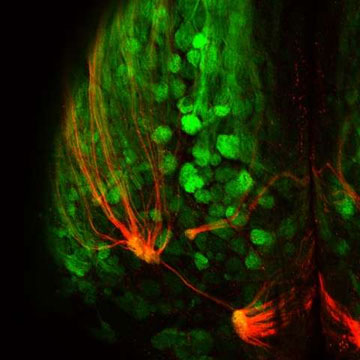
New York: Scientists have created super-sniffer mice that have an increased ability to detect a specific odour, and can be tuned to be used as land-mine detectors or as the basis for novel disease sensors.
The mice, which can be tuned to have different levels of sensitivity to any smell by using mouse or human odour receptors, were created by researchers at Hunter College, part
of the City University of New York.
The technology, a transgenic approach to engineering the mouse genome, could also provide researchers with a way to study human odour receptors.
"This is one of our five basic senses, yet we have almost no clue how odours are coded by the brain," said Paul Feinstein, an associate professor at Hunter College.
The noses of mammals contain a collection of sensory neurons, each equipped with a single chemical sensor called a receptor that detects a specific odour.
In mice, as in humans, each neuron selects only one receptor. Collectively, neurons choose an even distribution ofreceptors, so each of the thousand distinct receptors is represented in about 0.1 per cent of neurons.
To understand the mechanism these neurons use to choose a specific receptor, Feinstein tinkered with the mouse genome. He introduced the DNA for an odour receptor genetransgenically, by injection into the nucleus of a fertilised egg cell.
He also added an extra string of DNA to the gene sequence to see if it would alter the probability of the gene being chosen. After a few attempts, he found a string that, whencopied four or more times, worked.
More copies of this extra string of DNA resulted in aseries of super-sniffer mice with increasing numbers of neurons expressing the selected receptor, a well-characterised receptor that detects acetophenone, which has a sweet smellsimilar to jasmine.
Researchers used the transgenic super-sniffer technique to insert a human receptor gene into the mouse. "We have developed a system where we can study human odour receptors and finally determine how human odour coding works," said Feinstein.
The team validated that the mice do indeed have an amplified sense of smell for the given receptor. They first used fluorescent imaging in live mice to trace the activation of the amplified odour receptor in response to the receptor's corresponding odour. These tests gave visual confirmation that the receptors are functional and present in greater numbers than others.
In a standard behavioural test in which animals were trained to avoid an odour known to bind the transgenic receptor, the super-sniffer mice were able to detect the presence of this unpleasant odour in water at levels two orders of magnitude lower than those detectable by mice without super-sniffer abilities.
The study was published in the journal Cell Reports.

